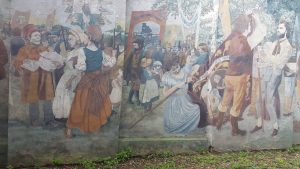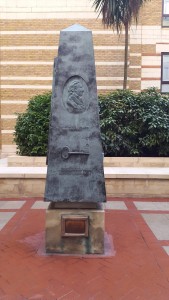Angel – its history and links to law
All of our first year law undergrads took part in an exercise in week one of their LLB where they escaped City and went to visit a number of buildings of significance in the local area, before tackling some research questions.
They were then asked to write a blog post inspired by their travels. 21 winners were selected from all those posts submitted – this is one of those – thanks to Waiyan Lau.

Angel is a modern area which is located on the northern fringe of Central London. It is named after The Angel Inn, which existed from the 17th century.
This explains why Angel encompasses a great quantity of historical landmarks since it has undergone huge changes over the years.
In this blog, I will explain why the four specified spots were signficant to legal events throughout the centuries.
These spots include the obelisk of Thomas Paine, George Orwell’s and Joe Orton’s living places and the painting wall in Edward Square.
Whilst strolling along the Islington High Street, Thomas Paine’s obelisk can be found in Angel Square. The obelisk commemorated the bicentenary of the publication of Paine’s book, Rights of Man (1791), which was written at the Angel Inn. Paine was an influential political writer. His support of revolution and republican government emboldened the American colonists to declare independence as well as introduce the idea of the Constitution.
In Rights of Man, he defines, “A constitution isn’t the act of a government, but of a government withought a constitution is power without right…A constitution is a thing antecedent to a government and a government is only the creature of a constitution.”
Nowadays, a constitution is a set of fundamental principles which helps to maintain law and order, makes the government accountable and sets out the rights of the people of the country. Consequently, Paine’s book was fundamental in establishing the Constitution in America.
A short distance away from Angel Square is Noel Road, where the famous playwright and author, Joe Orton, lived. In 1962, Orton and his partner Kenneth Halliwell were secretly removing books from several local public libraries, including Islington Public Library. They were each sentenced to six months imprisonment for ‘malicious damage’. The pair thought that the sentence was extremely harsh “because we were queers.” In addition to this, the fact that homosexuality was widely unaccepted meant that they received further injustice than was necessary. Even in our society today, attitudes vary greatly in different cultures. These laws are over four centuries old, deriving from the Buggery Act 1533 which identified anal sex and zoophilia as offences punishable by hanging. There was no legal recognition of same-sex marriages in the UK until Marriage (Same Sex Couples) Act 2013. Orton paved the way for these changes in attitude towards homosexuals in the UK.
Another author, George Orwell, lived in 27B Canonbury Square. His famous book, 1984, was released during the decade of political chaos: at the very end of the Second World War and at the beginning of the Cold War.. He addressed political issues in his novel, which raised awareness of social injustice and showed support towards the socialism. He had once been arrested for being drunk and was incapable of taking care of himself in 1931. His influence is still evident today as a student was arrested in Cairo University in Egypt for being in possession of 1984. Why is Orwell’s 1984 is so popular? It is a dystopia novel which presents a vision of a totalitarian future, in order to warn humans and hope to change their attitude towards the society.
From Copenhagen Street, I turn into Edward Square where a mural painted by David Bangs is situated on the wall. This was created in 1984 commemorating the protest march in 1834. Back in the 1830s, life in villages like Tolpuddle was poor and hard; a group of farm labourers had their wages significantly cut from 9 shilllings a week to 7 shillings. A further reduction was later threatened. Some farmers fought back by smashing the new farming machines but this brought harsh punishments.

In 1834, farm workers in West Dorset formed a lawful trade union in the hope of receiving guaranteed fair treatment from the government. The union grew rapidly but six leaders of the union were arrested and sentenced to seven years’ transportation for taking an oath of secrecy; it was a brutal punishment.
This led to a massive protest swept across the country. Around 100,000 people gathered at Copenhagen Fields, situated in North of Kings Cross in London, to protest against the arrest and harsh punishment of the Dorchester labourers. Many more organized petitions and protest meetings to demand their freedom. Finally, the protest campaign turned out successful and the Tolpuddle Martyrs returned home in triumph. Till now, the idea of solidarity as a basic human right is an international demand.
Angel is the most telling witness towards human rights and legal; people fought for, campaigned and promoted human rights and freedom. Living in Angel allows us to learn and understand the linkages between past and present; legal historical event is essential.


